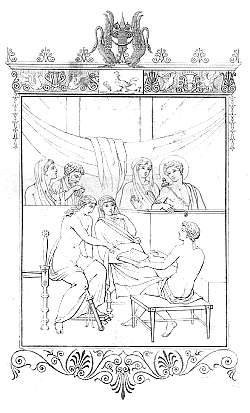Plate XLIV - Poet reading
|
It is impossible to see the Poet reading to two
personages who at first sight appear to be male and
female, without remembering the circumstance of Virgil
reciting that part of his poem to the emperor and
Octavia, which first produced tears, and at the words
«Tu Marcellus eris» threw her into a swoon,
from which she recovered to present a sum equal to 2000
of our pounds sterling to the poet whose verse had dope
so much towards immortalizing the memory of her
son. |
The dark colour of the Poet seems to have induced many
persons to imagine that he must be a slave ; but, admitting
this, we are still in the dark as to the subject of the
picture.
The locality resembles a modern theatre, with three persons
in the pit, and four others in the boxes, one of whom, on the
right, has that sort of blue glory which seems, in the
paintings of Pompeii, to be the attribute of divinity, or, at
least, of heroic personages.
The female, it is true, seems agitated, and is pointing as if
to command the repetition of some passage. The history
certainly mentions that after the words «O nate»
Octavia burst into tears ; and there is perhaps nothing but
the dress, or rather the absence of it, that should prevent
us from considering Virgil as the hero of the piece, or, at
least, that the story may have been similar.
If the house really belonged to a poet, it might have been
some triumph of his own which was here portrayed ; yet a god
with the blue glory and bow and a Muse would scarcely have
descended in the times of Imperial Rome, their visits to this
earth having long been suspended. An elderly figure on the
left, and another, with a crutch, seem personages of this
world ; and perhaps, when the picture becomes more known,
some one will hit upon the explanation.
Above the picture is the cock with the caduceus, and other
ornaments from the same house. The border with harpies is
perhaps the only ancient authority for the form of those
beings yet found.
The ornament below the picture is from one of the older
excavations.
The strong resemblance between some of the figures in this
painting to those in the celebrated picture from Herculaneum,
taken from the Iphigenia in Tauris of Euripides, ought
to be remarked. There is, perhaps, sufiicient reason for
thinking they refer to the same subject.
